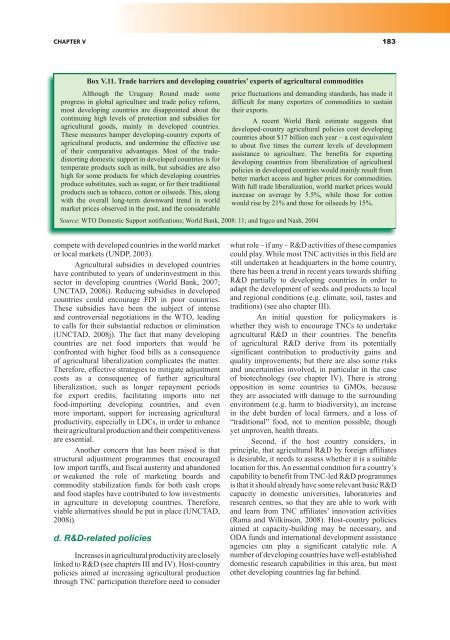World Investment Report 2009: Transnational Corporations - Unctad
World Investment Report 2009: Transnational Corporations - Unctad
World Investment Report 2009: Transnational Corporations - Unctad
You also want an ePaper? Increase the reach of your titles
YUMPU automatically turns print PDFs into web optimized ePapers that Google loves.
CHAPTER V 183<br />
Box V.11. Trade barriers and developing countries’ exports of agricultural commodities<br />
Although the Uruguay Round made some<br />
progress in global agriculture and trade policy reform,<br />
most developing countries are disappointed about the<br />
continuing high levels of protection and subsidies for<br />
agricultural goods, mainly in developed countries.<br />
These measures hamper developing-country exports of<br />
agricultural products, and undermine the effective use<br />
of their comparative advantages. Most of the trade-<br />
distorting domestic support in developed countries is for<br />
temperate products such as milk, but subsidies are also<br />
high for some products for which developing countries<br />
produce substitutes, such as sugar, or for their traditional<br />
products such as tobacco, cotton or oilseeds. This, along<br />
with the overall long-term downward trend in world<br />
market prices observed in the past, and the considerable<br />
compete with developed countries in the world market<br />
or local markets (UNDP, 2003).<br />
Agricultural subsidies in developed countries<br />
have contributed to years of underinvestment in this<br />
sector in developing countries (<strong>World</strong> Bank, 2007;<br />
UNCTAD, 2008i). Reducing subsidies in developed<br />
countries could encourage FDI in poor countries.<br />
These subsidies have been the subject of intense<br />
and controversial negotiations in the WTO, leading<br />
to calls for their substantial reduction or elimination<br />
(UNCTAD, 2008j). The fact that many developing<br />
countries are net food importers that would be<br />
confronted with higher food bills as a consequence<br />
of agricultural liberalization complicates the matter.<br />
Therefore, effective strategies to mitigate adjustment<br />
costs as a consequence of further agricultural<br />
liberalization, such as longer repayment periods<br />
for export credits, facilitating imports into net<br />
food-importing developing countries, and even<br />
more important, support for increasing agricultural<br />
productivity, especially in LDCs, in order to enhance<br />
their agricultural production and their competitiveness<br />
are essential.<br />
Another concern that has been raised is that<br />
structural adjustment programmes that encouraged<br />
low import tariffs, and fiscal austerity and abandoned<br />
or weakened the role of marketing boards and<br />
commodity stabilization funds for both cash crops<br />
and food staples have contributed to low investments<br />
in agriculture in developing countries. Therefore,<br />
viable alternatives should be put in place (UNCTAD,<br />
2008i).<br />
d. R&D-related policies<br />
Increases in agricultural productivity are closely<br />
linked to R&D (see chapters III and IV). Host-country<br />
policies aimed at increasing agricultural production<br />
through TNC participation therefore need to consider<br />
price fluctuations and demanding standards, has made it<br />
difficult for many exporters of commodities to sustain<br />
their exports.<br />
A recent <strong>World</strong> Bank estimate suggests that<br />
developed-country agricultural policies cost developing<br />
countries about $17 billion each year – a cost equivalent<br />
to about five times the current levels of development<br />
assistance to agriculture. The benefits for exporting<br />
developing countries from liberalization of agricultural<br />
policies in developed countries would mainly result from<br />
better market access and higher prices for commodities.<br />
With full trade liberalization, world market prices would<br />
increase on average by 5.5%, while those for cotton<br />
would rise by 21% and those for oilseeds by 15%.<br />
Source Source: : WTO Domestic Support notifications; <strong>World</strong> Bank, 2008: 11; and Ingco and Nash, 2004.<br />
what role – if any – R&D activities of these companies<br />
could play. While most TNC activities in this field are<br />
still undertaken at headquarters in the home country,<br />
there has been a trend in recent years towards shifting<br />
R&D partially to developing countries in order to<br />
adapt the development of seeds and products to local<br />
and regional conditions (e.g. climate, soil, tastes and<br />
traditions) (see also chapter III).<br />
An initial question for policymakers is<br />
whether they wish to encourage TNCs to undertake<br />
agricultural R&D in their countries. The benefits<br />
of agricultural R&D derive from its potentially<br />
significant contribution to productivity gains and<br />
quality improvements; but there are also some risks<br />
and uncertainties involved, in particular in the case<br />
of biotechnology (see chapter IV). There is strong<br />
opposition in some countries to GMOs, because<br />
they are associated with damage to the surrounding<br />
environment (e.g. harm to biodiversity), an increase<br />
in the debt burden of local farmers, and a loss of<br />
“traditional” food, not to mention possible, though<br />
yet unproven, health threats.<br />
Second, if the host country considers, in<br />
principle, that agricultural R&D by foreign affiliates<br />
is desirable, it needs to assess whether it is a suitable<br />
location for this. An essential condition for a country’s<br />
capability to benefit from TNC-led R&D programmes<br />
is that it should already have some relevant basic R&D<br />
capacity in domestic universities, laboratories and<br />
research centres, so that they are able to work with<br />
and learn from TNC affiliates’ innovation activities<br />
(Rama and Wilkinson, 2008). Host-country policies<br />
aimed at capacity-building may be necessary, and<br />
ODA funds and international development assistance<br />
agencies can play a significant catalytic role. A<br />
number of developing countries have well-established<br />
domestic research capabilities in this area, but most<br />
other developing countries lag far behind.

















